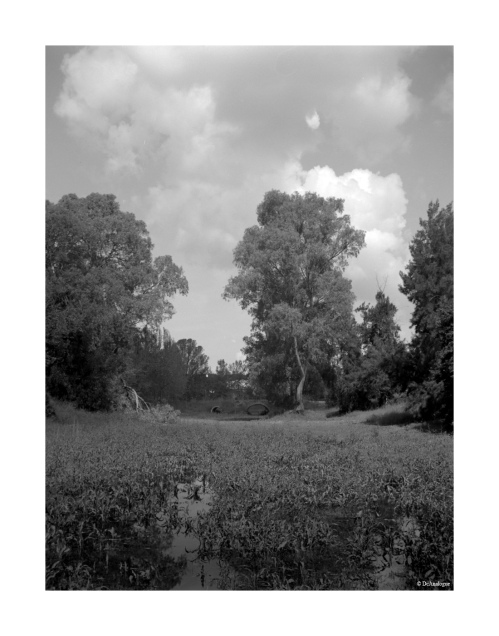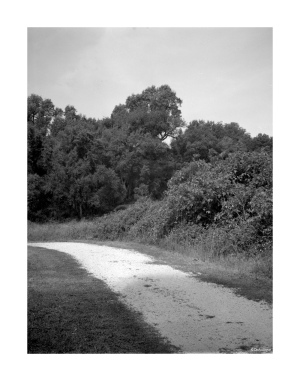She’s really small, almost looks like a toy. She fits in the pocket of a jacket and you almost do not notice but when you load the film, you put into the same 120 rolls of any other medium format camera and then you realize that you can take “serious” pictures with this one too. I’m talking about the Zeiss Ikon Nettar 515, a 6 x 4.5 cm folding camera which at the time belonged to Zeiss economic production line. I bought one for a few euros and couldn’t wait to test on field.
The specimen in question (should be around 1939) is equipped with Zeiss Nettar Anastigmat 7.5 cm f / 4.5, Klio shutter with speeds from 1 sec. to 1/175 sec plus bulb and T. The focus is guess estimated and framing is made through albada viewfinder. Not so comfortable to use, especially for those who has only been using modern dSLRs or smartphones. Never as in this case the rule is: take it easy! You decide the subject, estimate focus distance, then set it on the appropriate lens ring, measure the exposure (with an external exposure meter … of course, or with the rule of 16) and set the values of the times and diaphragms on their rings . But that’s not all! We must still cock the shutter and then frame the image. After that, we are ready to press the shutter button with… the left index finger! Not new for those accustomed to using foldings (not all but many have the shutter button on the left) but something really unsettling for any right-handed photographer. In the specific case of the 515, given the size 6 x 4.5 there is also to take into account that, by holding the camera normally, the images will be vertical and holding it vertically, these will be horizontal.

I say all this to those who have never used this kind of cameras. For those who, like myself, has been caught by the arrow of Cupid for folding cameras, the workflow is sufficiently acquired to not waste hours fiddling with dials and buttons before firing the shutter.
As test roll I used a Kodak T-Max 100. Among the “modern” films is not one that drives me crazy and for the same speed, I much prefer the Fuji Acros 100. I still had some Ars Imago Fd developer and developed the film with it @ 1 + 39 dilution.
The results? Vintage, really vintage! First, the camera works and does not seem to have problems, especially in the bellow which can often cause light leaks. The negatives have come out very soft (perhaps too soft) probably due to the type of development, and for the characteristics of the lens that nevertheless seems to have quite a resolving power (at least at apertures between f/8 and f /16). We must take into account that does not have any anti-reflective coating and that I did not have a lens hood. In one case, I used a yellow filter placed on the lens (the dedicated one is still on the way to my home) that seems to have helped a little the micro contrast. As always, I scanned the negatives keeping as neutral as possible the intervention of the scanning software and only adjusted the tone curves in post-production. I didn’t add any sharpening.
First exit, not bad, but next time maybe I will use a film I love most and know best such as Tri-x 400, to be developed in Rodinal. And maybe, I will have the lens hood that, with these vintage lenses is practically mandatory.
(Click on images to see larger)
Edit: you can check much (and better) more images made with this camera HERE
—-
(Versione Italiana)
E’ veramente piccola, sembra quasi un giocattolo. Sta nella tasca di un giaccone e quasi non te ne accorgi ma poi, quando la carichi, ci metti dentro gli stessi rulli 120 di qualsiasi altra medio formato e allora capisci che anche con questa potrai fare fotografie “serie”. Sto parlando della Zeiss Ikon Nettar 515, una fotocamera folding formato 6 x 4,5 cm che, all’epoca, apparteneva alla linea “economica” della Zeiss. Per pochi euro ne ho presa da poco una e non vedevo l’ora di provarla.
L’esemplare in questione (dovrebbe essere del 1939 circa) è dotato di obiettivo Zeiss Nettar Anastigmat 7,5 cm f/4,5, otturatore Klio con tempi da 1 sec. a 1/175 sec più posa B e T. La messa a fuoco frontale è a stima e l’inquadratura si effettua tramite un mirino a traguardo. Non comodissima da usare, specie per chi nella vita ha solo usato moderne digitali tutte automatiche o le fotocamere incorporate negli smartphones. Mai come in questo caso vale la regola del prendersela con calma. Si decide il soggetto della fotografia, si stima la distanza di messa a fuoco, la si riporta sull’apposita ghiera dell’obiettivo, si misura l’esposizione (con un esposimetro esterno…ovviamente, oppure con la regola del 16) e si riportano i valori sulle rispettive ghiere dei tempi e diaframmi. Ma, non è ancora tutto! Bisogna ancora armare l’otturatore e poi inquadrare. Dopodiché, siamo pronti per premere il pulsante di scatto con l’indice…. sinistro! Non una novità per chi è abituato ad usare le folding (non tutte ma molte hanno il pulsante di scatto a sinistra) ma qualcosa di veramente destabilizzante per qualsiasi fotografo destrimane. Nel caso specifico della 515, dato il formato 6 x 4,5 c’è anche da tener conto che, tenendo la fotocamera normalmente, le immagini saranno verticali e tenendola verticalmente, saranno orizzontali.
Dico tutto questo per chi non abbia mai usato questo genere di fotocamere. Per chi, come il sottoscritto, sia stato colto dalla freccia di Cupido per le folding, ormai la routine operativa è sufficientemente acquisita per non perdere ore armeggiando con ghiere e pulsanti.
Come rullo di prova ho usato una Kodak T-Max 100. Tra le pellicole di tipo “moderno” non è che mi faccia impazzire e per la stessa sensibilità, preferisco di gran lunga la Fuji Acros 100. Avevo ancora un po’ del campione di sviluppo Ars Imago Fd e l’ho sviluppata con quest’ultimo alla diluizione 1+39.
I risultati? Vintage, che più vintage non si può! Per prima cosa, la fotocamera funziona e non sembra avere problemi, specie nel soffietto che spesso può essere causa di infiltrazioni di luce. I negativi sono usciti fuori molto morbidi (forse troppo) sia probabilmente per il tipo e le modalità di sviluppo, quanto per le caratteristiche della lente che comunque sembra avere un discreto potere risolvente (almeno ai diaframmi tra f/8 e f/16). Dobbiamo tener conto che non ha un trattamento antiriflesso e che non disponevo di un paraluce. In un caso, ho usato un filtro giallo appoggiato sulla lente (quello dedicato è ancora in viaggio) che sembra aver giovato un poco al micro contrasto. Come sempre, ho scansionato i negativi mantenendo il più neutro possibile l’intervento del software di scansione e sono intervenuto in seguito regolando esclusivamente le curve di contrasto. Non è stato aggiunto nessuno sharpening.
Come prima uscita, non male, ma la prossima volta magari userò una pellicola che amo di più e conosco meglio come la Tri-x 400, da sviluppare in Rodinal. E magari, avrò anche il paraluce che, con queste lenti vintage è un accessorio praticamente…. obbligatorio.
EDIT: potete vedere molte più (ed anche migliori) immagini scattate con questa fotocamera QUI
Tech data:
Camera: Zeiss Ikon Nettar 515 – Film: Kodak T- Max 100 – Developer: Ars-Imago Fd – Scanner: Epson V550






These do have a very vintage feel to them that I like very much. Nice set of images!
LikeLiked by 1 person
Thanks Chris!
LikeLike
complimenti. ottimi risultati, tecnici e artistici!
LikeLiked by 1 person
Grazie Fabio! 😉
LikeLike
I am really enjoying your camera tests. Really nice photographs!
LikeLiked by 1 person
Thanks Jordi! 😉 I’m happy to do something which give people some pleasure and share my experiences. Hope to do always better…. 😀
LikeLike
It proves that you can produce a great image with some of the old kit, I love the first shot and the latter one of the tree on its own
LikeLike
Thanks!
You can find better ones (made with the same camera) in the post “A busy Sunday”…. 😉
LikeLike
Lovely pics from a cute camera!
LikeLiked by 1 person
Thanks jabcam! She’s really cute and takes great shots (as you can see better in another post: a busy sunday).
After this test…. I bought another one…. 😉
LikeLike